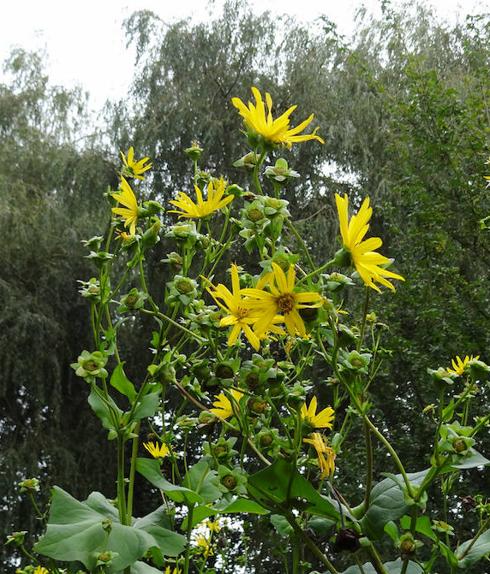

Secciones
Servicios
Destacamos

Denise Bush
Monday, 24 July 2017, 09:21
The Virginia cup plant or Silphium perfoliatum, also commonly called Roisin Weed, will reach about two metres tall once fully grown. It has a habit of sprawling through the border with the flowers peering over the top of other plants unless is it adequately supported.
It is native to eastern and central North America where it grows on moist river banks and on prairie land. Once established, the cup plant is drought-tolerant for short periods and can become invasive in an ideal habitat, eventually forming dense colonies.
The cup plant has long, tapering, green leaves which join together to form a cup around the stem. Water collects in these cups and attracts birds, bees and butterflies. The stems are square in cross section and in some species turn an attractive red. The sulphur-yellow, daisy-like flowers appear from July to September.
One species of this plant, which is thought to have been closely related to parsley or giant fennel, is unfortunately now believed to be extinct due to the Romans overexploiting it. The sap of this plant was called laser or laserpicum and was invaluable to the Romans for contraception. It was so sought-after that it was sold by weight at the same going rate as silver.
The ancient Greek city of Cyrene (now Libya) was the centre of its production and it was so important to the economy that the plant was featured on the currency. Also on some coins was a symbol of the seed of Silphium which is possibly the first appearance of the double-lobed, heart shape which has become the modern day symbol for romance.
The sap was the most effective form of contraception of the time and was used across the Mediterranean for over 700 years.
Unfortunately by 1BC it had disappeared although some botanists believe it is still out there somewhere, albeit misidentified. None of the Silphiums available today have the same properties as the plant the Romans regarded so highly. Although Silphium has a tap root it forms lateral rhizomes that can be used to propagate it in spring.
Publicidad
Publicidad
Publicidad
Publicidad
Esta funcionalidad es exclusiva para registrados.
Reporta un error en esta noticia

Debido a un error no hemos podido dar de alta tu suscripción.
Por favor, ponte en contacto con Atención al Cliente.

¡Bienvenido a SURINENGLISH!

Tu suscripción con Google se ha realizado correctamente, pero ya tenías otra suscripción activa en SURINENGLISH.
Déjanos tus datos y nos pondremos en contacto contigo para analizar tu caso

¡Tu suscripción con Google se ha realizado correctamente!
La compra se ha asociado al siguiente email
Comentar es una ventaja exclusiva para registrados
¿Ya eres registrado?
Inicia sesiónNecesitas ser suscriptor para poder votar.